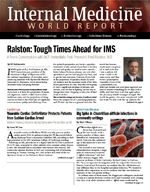Publication
Article
Internal Medicine World Report
Big Spike in Clostridium difficile infections in community settings
Big Spike in Clostridium difficileinfections in community settings
By Kurt Ullman
Clostridium difficileincidence has increased over the last decade, with a greater number of these cases identified as community-associated. However, the epidemiology of the infection is not well understood.
“We noticed at our Veterans Administration Hospital, a large spike in community-acquired C. difficileinfections,” said lead author Susanna Naggie, MD, assistant professor at Duke University Medical Center in Durham, NC. “In a retrospective investigation with the help of the Centers for Disease Control and Prevention, we realized that the risk factors are very different than in the hospital-associated infection. We wanted to identify other exposures, or and to confirm that this was indeed an epidemic in the out-patient setting.”
To address some of these issues, Dr. Naggie and colleagues conducted a study at 5 centers between October 2006 and November 2007. During that time, 1041 adult infections with C. difficilewere confirmed by screening all positive C. difficile positive toxin assays reported daily from each laboratory. Of these, 162 (15.5%) met the criteria for the community-associated form. There were 66 case and 114 control patients enrolled in the studies. Case patients were young (median 64 years), female (56%), and often required hospitalization (38%).
“Up until this time, most of the information we had was from studies of large databases and there really wasn’t a lot of human-to-human contact,” she said. “I think everyone realizes that when you are trying to look for exposures, there are a number that won’t be captured in any database or medical record. There was a need for more feet-on-the-ground epidemiological work that hadn’t been done before.”
Several medications, including antimicrobials, antimotility agents, and opiates, had a positive association with infection, but only antimicrobials remained in the adjusted analysis. In particular, penicillin (adjusted odds ratio [OR] 3.38; 95% confidence interval [CI]), cephalosporin ( OR 8.84; 95% CI 1.85-42.3), and clindamycin (OR 6.64; 95% CI 1.34-33) were more common among cases. Multiple community exposure factors were assessed, with malignancy, exposure to high-risk persons, and hospitalization more than 2 years earlier being independently associated with a community-associated infection. In 40% of the cases, the group was unable to confirm any antibiotic treatment. Unlike other studies, no association was found with proton pump inhibitor medicines.
Their findings have some major implications for community physicians. Even though these patients were younger and healthier that than seen in the typical hospital-associated infection, close to 40% eventually became sick enough to require hospitalization.
“When people come in with diarrhea, unless they have a history of recent hospitalizations or antibiotic use, we don’t often think about getting a C. difficile toxin assay,” said Dr. Naggie. “Our results show that we need to consider C. difficile infection when evaluating a patient who has an outpatient diarrheal illness. Our risk assessments need to be expanded to include asking them about visiting others in the hospital, recent illnesses in the home, and about their own hospitalizations going back as far as two years.”
Author Disclosures: The authors reported no apparent conflicts of interest.
Source:Naggie S, et al. A case-controlled study of community-associated Clostridium difficile infection: No role for proton pump inhibitors. Am J Med. 2011; 124:276.e1-276.e7.
